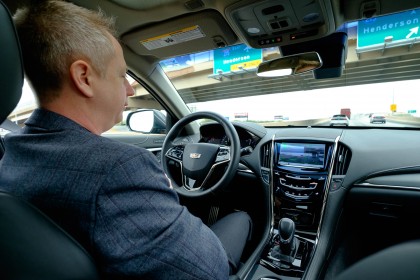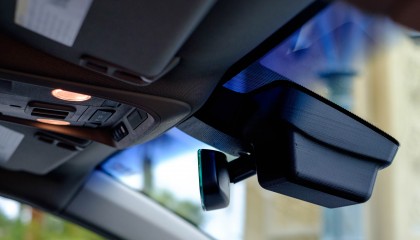Magna demos affordable semi-autonomous driving technology
It's not fully autonomous, but it doesn't need to be
It's not a CES without an autonomous driving demo, and today I got to experience affordable autonomous driving capabilities from Magna International.
Magna isn't a household name to the average car buying public, but it's a large supplier of the parts and technology that go into making a car. Its all-wheel drive system can be found in many Hyundais and Kias, including the Tucson we recently tested.
Magna's semi-autonomous driving demo consisted of a production Cadillac ATS with forward collision warning, adaptive cruise control and lane keep assist technologies. The car comes from the factory with the ability to control speed and help keep the car within the lane markers through a combination of radar and camera sensors.
The demo car has the car's driver assist technologies disabled, with the radar sensor required for adaptive cruise control to function physically disconnected. Magna hacked into the vehicle's CANbus to take control of the car's gas and brake pedals, and lane keep assist steering functions to provide semi-autonomous driving capabilities with a single front-mounted camera, which lane keep assist and forward collision warning technologies rely on.

Using a single camera, the Magna semi-autonomous car can read road lane markers, speed limit signs, detect cars ahead and traffic lights. I rode in the back seat while the Magna representative showed how the system works. In its current state, the system only works on highways to provide semi-autonomous functions so you can relax but still have to pay attention, somewhat, at least.
We got on the freeway and with the press of a button, the car took over driving capabilities; no hands on the steering wheel required. Magna provided a feed of what the camera sees and detects to the infotainment screen, which was cool to see what objects were detected. It had no troubles detecting other cars on the road, the speed limit, traffic lights and pedestrians.
The controlled demo had a dedicated car to follow, or supposed to, but other cars on the road got between the lead car and the ATS. Nevertheless, the demo wasn't perfect but impressive. The car had some trouble reading the poor lane markers in Las Vegas, but had no problems driving along the freeway. Steering was a little twitchy when the system had troubles reading the lanes, but I never feared for my safety.
Get daily insight, inspiration and deals in your inbox
Sign up for breaking news, reviews, opinion, top tech deals, and more.

Overall, the demo was a little rough around the edges, but it's a work-in-progress tech demo. The practical applications for this among mainstream cars is what excites me. Forward collision prevention and lane keep assist systems are making their way into mainstream compact cars such as the new Honda Civic and next-generation Hyundai Elantra, so the required hardware for semi-autonomous highway cruising or traffic jam assist features are already installed in the car. With an additional computing unit to perform the detection computations, we can have semi-autonomous driving features similar to Mercedes-Benz's Distronic Plus in a vehicle that's a half the price.